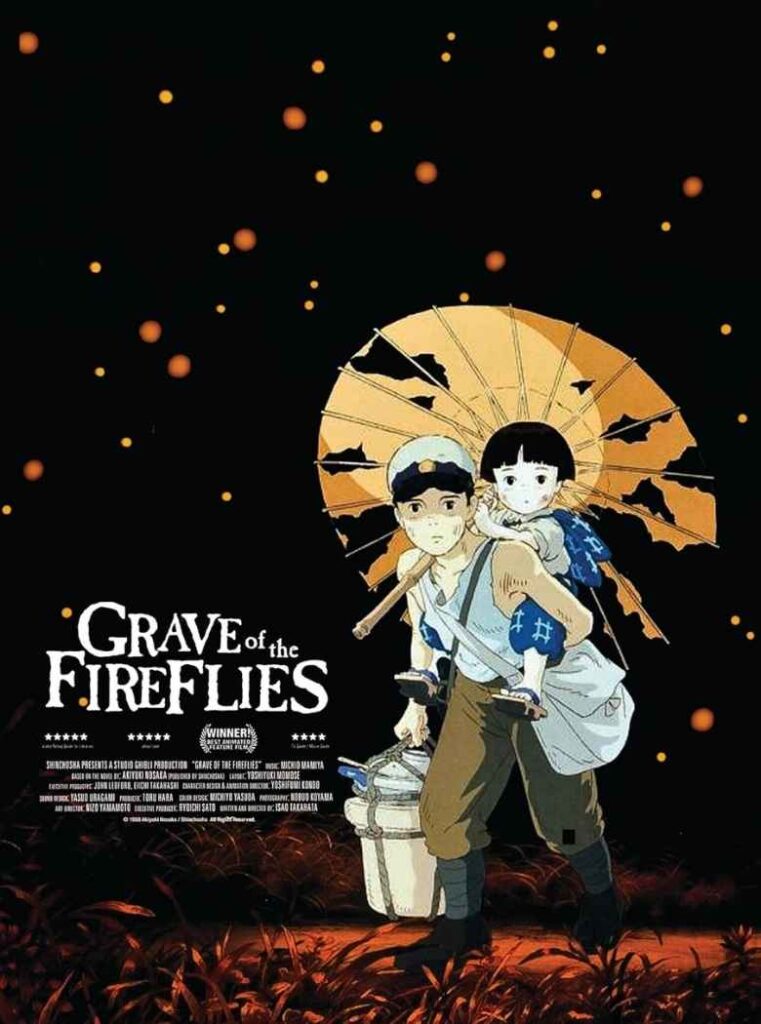Grave of the Fireflies: On a quiet summer night in war-torn Japan, a boy named Seita sits in a train station, weak and starving. As people pass him by, indifferent to his suffering, his story begins—one of love, loss, and survival in the final days of World War II. Grave of the Fireflies is not just a movie; it is a heartbreaking tale that lingers in the hearts of all who watch it.

Movie Details
| Title | Grave of the Fireflies (Hotaru no Haka) |
|---|---|
| Director | Isao Takahata |
| Studio | Studio Ghibli |
| Release Date | April 16, 1988 (Japan) |
| Runtime | 89 minutes |
| Genre | War, Drama, Historical |
| Language | Japanese (with multiple dubbed versions) |
| IMDb Rating | 8.5/10 |
| Number of Reviews | Approximately 343,000 user reviews |
| IMDb Link | IMDb Page |
A World in Flames
In the final months of World War II, Japan is under relentless attack by American bombers. One fateful night, the city of Kobe is set ablaze by firebombs. Amid the chaos, a teenage boy named Seita desperately tries to save his little sister, Setsuko. As the fires rage, their world crumbles.
Their mother, gravely injured in the bombing, is taken to a hospital. Seita, knowing the truth but unable to tell his sister, tries to protect her from the horror. But soon, the harsh reality sets in—their mother has died.
With their father serving in the Imperial Navy and no home left to return to, Seita and Setsuko are alone in a world that has no place for them.
A Brother’s Promise
At first, the siblings find shelter with a distant aunt. But war brings out both kindness and cruelty in people. Their aunt grows resentful, calling them a burden. She tells Seita he should work for food and criticizes him for not joining the war effort. The once-warm home turns cold.
Tired of being treated as unwanted guests, Seita makes a decision: he and Setsuko will survive on their own.
They find an abandoned bomb shelter near a river and turn it into their new home. Fireflies light up the dark nights, and for a brief moment, they create a world of their own, free from war and suffering. Setsuko laughs as she chases the glowing insects, and Seita smiles, knowing he is all she has.
But reality cannot be ignored for long.
The Slow Descent
With no money and no food, Seita struggles to keep his sister fed. The war has left people with little to spare, and no one is willing to help. He steals from farms, but it is not enough. Hunger begins to take its toll.
Setsuko, too young to understand, becomes weaker each day. She cries for food, her tiny body growing frail. In a heartbreaking moment, she offers Seita a marble, thinking it is a piece of candy. Desperation pushes Seita to do the unthinkable—he breaks into a home to steal food but is caught and beaten.
When he returns to the shelter, Setsuko is barely conscious. She hallucinates, offering him invisible rice balls, her body too weak to even cry. Seita, determined to save her, takes their last savings and rushes to buy food.
But it is too late.
A Firefly’s Final Glow
On a warm summer evening, Setsuko takes her last breath. Seita, devastated, cremates her tiny body, placing her ashes in a candy tin—the same one she once cherished.
With nothing left, Seita wanders the war-torn streets, a ghost among the living. Soon, his strength gives out, and he collapses in a train station, surrounded by people who do not care. His final moments are spent holding the tin that carries the remains of the only person he ever loved.
As the movie ends, the spirits of Seita and Setsuko watch over the city, finally free from their suffering. The fireflies, symbols of their fleeting lives, glow softly in the night.
What This Movie Teaches Us
Grave of the Fireflies is a heartbreaking reminder of the innocent lives lost in war. It teaches us that war is not just about soldiers and battles—it is about children like Seita and Setsuko, who are forgotten in the destruction.
The film shows the importance of family, love, and kindness. It reminds us that even in the darkest times, moments of beauty—like the glow of fireflies—can still exist. But those moments are fragile, and once lost, they can never be reclaimed.
My Honest Review
Unlike other Studio Ghibli films filled with magic and adventure, Grave of the Fireflies tells a real and painful story. It does not shy away from the horrors of war but presents them through the eyes of two children.
It is a film that stays with you long after the credits roll. It makes you appreciate the life you have, the food on your table, and the people who love you. It is a movie that does not just tell a story—it makes you feel it.
If you watch this film, be prepared. It is not an easy watch, but it is an important one.
FAQ – Grave of the Fireflies
1. Is Grave of the Fireflies based on a true story?
Yes. The movie is based on a semi-autobiographical novel by Akiyuki Nosaka, who lost his sister during World War II due to starvation. The story is his way of expressing the guilt he carried for not being able to save her.
2. Why is the movie called Grave of the Fireflies?
Fireflies symbolize beauty, innocence, and fleeting life. Just like fireflies glow brightly but die quickly, Seita and Setsuko’s lives are tragically short yet full of warmth and love.
3. Why did Seita and Setsuko leave their aunt’s house?
Their aunt treated them as burdens, making them feel unwanted. Seita, wanting to protect Setsuko’s happiness, decided they should live on their own, not realizing how difficult survival would be.
4. Why didn’t Seita ask for help?
During wartime, resources were scarce, and people prioritized their own survival. Seita was young and proud, believing he could take care of Setsuko alone. By the time he realized he needed help, it was too late.
5. What is the significance of the candy tin?
The candy tin represents love and loss. It was one of the few joys Setsuko had, and after her death, it became her resting place, holding her ashes. Even in death, it was a reminder of her innocence.







